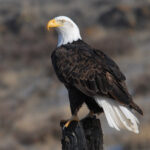Yes, there are Bald Eagles in Tennessee. The Bald Eagle population in Tennessee has rebounded significantly in recent years, with over 175 nesting pairs in the state as of 2012. Most of these birds remain in the state year-round, but individuals from more northern breeding populations migrate to Tennessee for the winter.
Bald Eagle Nesting in Tennessee
Bald Eagles in Tennessee typically nest in the tops of large trees near openings, and their nests can reach up to 8 feet across and 12 feet deep. They lay their eggs in late February, with an average clutch size of two eggs. Both parents incubate the eggs for 34 to 36 days, and the nestlings fledge after 10 to 12 weeks.
Bald Eagle Population Recovery in Tennessee
 Image source: Pexels by Anrita Krause
Image source: Pexels by Anrita Krause
The Bald Eagle was once on the brink of extinction in the lower 48 states due to reproductive failure caused by the pesticide DDT. However, thanks to the banning of DDT, habitat protections provided by the Endangered Species Act, and aggressive reintroduction programs, the Bald Eagle population has recovered sufficiently to be removed from the federal list of threatened and endangered species in 2007.
Bald Eagle Protection in Tennessee
Despite this recovery, the Bald Eagle still receives protection under the Migratory Bird Treaty Act and the Bald Eagle and Golden Eagle Protection Act. This means that it is illegal to hunt, kill, or possess Bald Eagles, and their nests and habitats are also protected.
Bald Eagle Viewing Opportunities in Tennessee
Tennessee offers several great opportunities to observe Bald Eagles in their natural habitat. Some of the best places to see Bald Eagles in Tennessee include:
- Reelfoot Lake: This large lake in the northwest corner of the state is a popular wintering ground for Bald Eagles, with as many as 200 birds observed during the winter months.
- Chickamauga Lake: This reservoir on the Tennessee River is home to a growing population of Bald Eagles, with several nesting sites along the shoreline.
- Tellico Lake: This lake in the foothills of the Smoky Mountains is another hotspot for Bald Eagle viewing, particularly during the winter months.
- Hiwassee Wildlife Refuge: This refuge in southeast Tennessee is a designated Bald Eagle viewing area, with a variety of viewing platforms and trails for visitors to observe the birds.
Bald Eagle Identification
Bald Eagles are large birds of prey, with a wingspan of up to 8 feet and a body length of up to 3 feet. They have a distinctive white head and tail, with a dark brown body and wings. Juvenile Bald Eagles, on the other hand, have a dark brown head and tail, and their plumage gradually becomes whiter as they mature.
Bald Eagle Behavior
Bald Eagles are known for their impressive hunting skills, often swooping down from the sky to snatch fish from the water with their sharp talons. They are also known for their impressive aerial displays, where they perform acrobatic maneuvers and engage in aerial battles with other eagles.
Bald Eagle Conservation Efforts in Tennessee
In addition to the federal protections, the Tennessee Wildlife Resources Agency (TWRA) has also taken steps to protect and conserve the state’s Bald Eagle population. This includes monitoring nesting sites, enforcing hunting and habitat regulations, and educating the public about the importance of Bald Eagle conservation.
Conclusion
The Bald Eagle is a true symbol of American wildlife, and its recovery in Tennessee is a testament to the success of conservation efforts. With over 175 nesting pairs in the state, Bald Eagles are a common sight in many parts of Tennessee, particularly during the winter months. Whether you’re an avid birdwatcher or just someone who appreciates the beauty of nature, there are plenty of opportunities to observe these majestic birds in their natural habitat in Tennessee.



